Opinion & Analysis
Long irons or hybrids? The importance of bag setup

Merion Golf Club’s East Course, the site of the 2013 U.S. Open, saw players use a variety of different equipment setups in order to navigate the course’s combination of very long and very short holes.
Bag setup was one of the parts of the game I was very interested in when I started doing my statistical research. And from my experience, even Tour players have a variety of opinions on what type of bag setup to use come tournament time.
In my debut column for GolfWRX, I discussed that if you broke the game down into more finite details, you will see that shots from what I call “The Danger Zone” (approach shots from 175 to 225 yards) have the strongest mathematical correlation to success on Tour.
There are many ways to “skin a cat” when it comes to lowering a golfer’s score, but those who struggle from the Danger Zone are putting themselves behind the 8-ball and will require better play from the other facets of the game to make up for that deficiency.
With that said, I wanted to look at what the best Danger Zone players on Tour were carrying for a bag setup. To do this, I looked at the number of irons each player carried in 2010, 2011 and 2012:
Note: I left out the sixth-ranked player from the Danger Zone in 2010, Jay Williamson, due to being unable to find any record of his bag setup in 2010.
Here is the final tally of bag setups for the players listed:
As we can see, the overwhelming majority of Tour players carry a bag setup of a 3 iron through pitching wedge. The rest mostly carry a bag setup of 4 iron through pitching wedge. And only one player in the list used a bag setup of 5 iron through pitching wedge — Graeme McDowell.
What this means is that Tour players are carrying fewer wedges and/or fewer hybrids than the average amateur. I feel most of that has to do with their skill level, which alters the purpose of long irons, hybrids and gap wedges with relationship to their game.
First, the thing that sticks out with the top Danger Zone players is that they typically make sure to have their yardage gaps tight from their 3-wood to the long irons. This means that there is usually no wide gaps between long clubs, like a player having a 3 wood and then the next club being a 3 iron. They typically have another club in-between the two like a hybrid or a 5-wood. And they usually end up not using a gap wedge in order to make sure they have the proper gaps for their long approach shots.
The reason why this works is that Tour players are skilled enough that if they get into a situation where they are in-between wedges and could use a gap wedge, they can simply take some distance off with their pitching wedge, or hit their sand wedge a little harder. They’re skilled and creative enough to still hit very good shots when they do this. But, when they get into a situation where they are in-between clubs from long distance, it is much more difficult for them to execute a shot by hitting a “soft” 3-wood or a “hard” 3 iron.
Another interesting aspect is the average club head speed of the players with the certain aspect as noted in this chart:
As we can see, the more irons the top Danger Zone players carry in their bags, the higher their club head speed is.
From my experience of discussing bag setups with Tour players, they feel that the irons are more precise and accurate than hybrids. However, if they want to increase their odds of consistently hitting a shot the furthest, they prefer hybrids over irons.
So, if they get on a long par-3 where they may have some difficulty clearing the water, they are apt to pull out the hybrid instead of a long iron in order to increase their odds of doing so. But if there is no trouble that they have to carry, they are likely want to use a long iron so they can hit a shot closer to the hole. And that explains why golfers who uses 2 iron-through-pitching wedge setups have super high clubhead speeds. They simply have little difficulty carrying any trouble in front of them because they hit it so far.
Therefore, I feel that hybrids should be considered more of an “advancement” club than anything for all golfers. For the Tour player, they need the hybrid if they are trying to advance the ball from a bad lie or if they are trying to ensure that they advance a ball over trouble like water, a bunker or other types of hazards.
For the average amateur, they are not likely to be able to hit a long approach close to the hole and can even struggle to find the green from long distance. Therefore, they are better off carrying more hybrids just so they can be more consistent in their ability to advance the ball toward the hole. If they have a 180-yard shot, they will be better off using a club that they will consistently hit in excess of 170 yards even if it causes them more issues with directional control.
In the end, whether the golfer is 2013 U.S Open winner Justin Rose or 20-handicap Joe Smith, their game can benefit from a proper bag setup that matches their ability.
Opinion & Analysis
The 2 primary challenges golf equipment companies face

As the editor-in-chief of this website and an observer of the GolfWRX forums and other online golf equipment discourse for over a decade, I’m pretty well attuned to the grunts and grumbles of a significant portion of the golf equipment purchasing spectrum. And before you accuse me of lording above all in some digital ivory tower, I’d like to offer that I worked at golf courses (public and private) for years prior to picking up my pen, so I’m well-versed in the non-degenerate golf equipment consumers out there. I touched (green)grass (retail)!
Complaints about the ills of and related to the OEMs usually follow some version of: Product cycles are too short for real innovation, tour equipment isn’t the same as retail (which is largely not true, by the way), too much is invested in marketing and not enough in R&D, top staffer X hasn’t even put the new driver in play, so it’s obviously not superior to the previous generation, prices are too high, and on and on.
Without digging into the merits of any of these claims, which I believe are mostly red herrings, I’d like to bring into view of our rangefinder what I believe to be the two primary difficulties golf equipment companies face.
One: As Terry Koehler, back when he was the CEO of Ben Hogan, told me at the time of the Ft Worth irons launch, if you can’t regularly hit the golf ball in a coin-sized area in the middle of the face, there’s not a ton that iron technology can do for you. Now, this is less true now with respect to irons than when he said it, and is less and less true by degrees as the clubs get larger (utilities, fairways, hybrids, drivers), but there remains a great deal of golf equipment truth in that statement. Think about it — which is to say, in TL;DR fashion, get lessons from a qualified instructor who will teach you about the fundamentals of repeatable impact and how the golf swing works, not just offer band-aid fixes. If you can’t repeatably deliver the golf club to the golf ball in something resembling the manner it was designed for, how can you expect to be getting the most out of the club — put another way, the maximum value from your investment?
Similarly, game improvement equipment can only improve your game if you game it. In other words, get fit for the clubs you ought to be playing rather than filling the bag with the ones you wish you could hit or used to be able to hit. Of course, don’t do this if you don’t care about performance and just want to hit a forged blade while playing off an 18 handicap. That’s absolutely fine. There were plenty of members in clubs back in the day playing Hogan Apex or Mizuno MP-32 irons who had no business doing so from a ballstriking standpoint, but they enjoyed their look, feel, and complementary qualities to their Gatsby hats and cashmere sweaters. Do what brings you a measure of joy in this maddening game.
Now, the second issue. This is not a plea for non-conforming equipment; rather, it is a statement of fact. USGA/R&A limits on every facet of golf equipment are detrimental to golf equipment manufacturers. Sure, you know this, but do you think about it as it applies to almost every element of equipment? A 500cc driver would be inherently more forgiving than a 460cc, as one with a COR measurement in excess of 0.83. 50-inch shafts. Box grooves. And on and on.
Would fewer regulations be objectively bad for the game? Would this erode its soul? Fortunately, that’s beside the point of this exercise, which is merely to point out the facts. The fact, in this case, is that equipment restrictions and regulations are the slaughterbench of an abundance of innovation in the golf equipment space. Is this for the best? Well, now I’ve asked the question twice and might as well give a partial response, I guess my answer to that would be, “It depends on what type of golf you’re playing and who you’re playing it with.”
For my part, I don’t mind embarrassing myself with vintage blades and persimmons chasing after the quasi-spiritual elevation of a well-struck shot, but that’s just me. Plenty of folks don’t give a damn if their grooves are conforming. Plenty of folks think the folks in Liberty Corner ought to add a prison to the museum for such offences. And those are just a few of the considerations for the amateur game — which doesn’t get inside the gallery ropes of the pro game…
Different strokes in the game of golf, in my humble opinion.
Anyway, I believe equipment company engineers are genuinely trying to build better equipment year over year. The marketing departments are trying to find ways to make this equipment appeal to the broadest segment of the golf market possible. All of this against (1) the backdrop of — at least for now — firm product cycles. And golfers who, with their ~15 average handicap (men), for the most part, are not striping the golf ball like Tiger in his prime and seem to have less and less time year over year to practice and improve. (2) Regulations that massively restrict what they’re able to do…
That’s the landscape as I see it and the real headwinds for golf equipment companies. No doubt, there’s more I haven’t considered, but I think the previous is a better — and better faith — point of departure when formulating any serious commentary on the golf equipment world than some of the more cynical and conspiratorial takes I hear.
Agree? Disagree? Think I’m worthy of an Adam Hadwin-esque security guard tackle? Let me know in the comments.
@golfoncbs The infamous Adam Hadwin tackle ? #golf #fyp #canada #pgatour #adamhadwin ? Ghibli-style nostalgic waltz – MaSssuguMusic
Podcasts
Fore Love of Golf: Introducing a new club concept

Episode #16 brings us Cliff McKinney. Cliff is the founder of Old Charlie Golf Club, a new club, and concept, to be built in the Florida panhandle. The model is quite interesting and aims to make great, private golf more affordable. We hope you enjoy the show!
Opinion & Analysis
On Scottie Scheffler wondering ‘What’s the point of winning?’

Last week, I came across a reel from BBC Sport on Instagram featuring Scottie Scheffler speaking to the media ahead of The Open at Royal Portrush. In it, he shared that he often wonders what the point is of wanting to win tournaments so badly — especially when he knows, deep down, that it doesn’t lead to a truly fulfilling life.
View this post on Instagram
“Is it great to be able to win tournaments and to accomplish the things I have in the game of golf? Yeah, it brings tears to my eyes just to think about it because I’ve literally worked my entire life to be good at this sport,” Scheffler said. “To have that kind of sense of accomplishment, I think, is a pretty cool feeling. To get to live out your dreams is very special, but at the end of the day, I’m not out here to inspire the next generation of golfers. I’m not out here to inspire someone to be the best player in the world, because what’s the point?”
Ironically — or perhaps perfectly — he went on to win the claret jug.
That question — what’s the point of winning? — cuts straight to the heart of the human journey.
As someone who’s spent over two decades in the trenches of professional golf, and in deep study of the mental, emotional, and spiritual dimensions of the game, I see Scottie’s inner conflict as a sign of soul evolution in motion.
I came to golf late. I wasn’t a junior standout or college All-American. At 27, I left a steady corporate job to see if I could be on the PGA Tour starting as a 14-handicap, average-length hitter. Over the years, my journey has been defined less by trophies and more by the relentless effort to navigate the deeply inequitable and gated system of professional golf — an effort that ultimately turned inward and helped me evolve as both a golfer and a person.
One perspective that helped me make sense of this inner dissonance around competition and our culture’s tendency to overvalue winning is the idea of soul evolution.
The University of Virginia’s Division of Perceptual Studies has done extensive research on reincarnation, and Netflix’s Surviving Death (Episode 6) explores the topic, too. Whether you take it literally or metaphorically, the idea that we’re on a long arc of growth — from beginner to sage elder — offers a profound perspective.
If you accept the premise literally, then terms like “young soul” and “old soul” start to hold meaning. However, even if we set the word “soul” aside, it’s easy to see that different levels of life experience produce different worldviews.
Newer souls — or people in earlier stages of their development — may be curious and kind but still lack discernment or depth. There is a naivety, and they don’t yet question as deeply, tending to see things in black and white, partly because certainty feels safer than confronting the unknown.
As we gain more experience, we begin to experiment. We test limits. We chase extreme external goals — sometimes at the expense of health, relationships, or inner peace — still operating from hunger, ambition, and the fragility of the ego.
It’s a necessary stage, but often a turbulent and unfulfilling one.
David Duval fell off the map after reaching World No. 1. Bubba Watson had his own “Is this it?” moment with his caddie, Ted Scott, after winning the Masters.
In Aaron Rodgers: Enigma, reflecting on his 2011 Super Bowl win, Rodgers said:
“Now I’ve accomplished the only thing that I really, really wanted to do in my life. Now what? I was like, ‘Did I aim at the wrong thing? Did I spend too much time thinking about stuff that ultimately doesn’t give you true happiness?’”
Jim Carrey once said, “I think everybody should get rich and famous and do everything they ever dreamed of so they can see that it’s not the answer.”
Eventually, though, something shifts.
We begin to see in shades of gray. Winning, dominating, accumulating—these pursuits lose their shine. The rewards feel more fleeting. Living in a constant state of fight-or-flight makes us feel alive, yes, but not happy and joyful.
Compassion begins to replace ambition. Love, presence, and gratitude become more fulfilling than status, profits, or trophies. We crave balance over burnout. Collaboration over competition. Meaning over metrics.
Interestingly, if we zoom out, we can apply this same model to nations and cultures. Countries, like people, have a collective “soul stage” made up of the individuals within them.
Take the United States, for example. I’d place it as a mid-level soul: highly competitive and deeply driven, but still learning emotional maturity. Still uncomfortable with nuance. Still believing that more is always better. Despite its global wins, the U.S. currently ranks just 23rd in happiness (as of 2025). You might liken it to a gifted teenager—bold, eager, and ambitious, but angsty and still figuring out how to live well and in balance. As much as a parent wants to protect their child, sometimes the child has to make their own mistakes to truly grow.
So when Scottie Scheffler wonders what the point of winning is, I don’t see someone losing strength.
I see someone evolving.
He’s beginning to look beyond the leaderboard. Beyond metrics of success that carry a lower vibration. And yet, in a poetic twist, Scheffler did go on to win The Open. But that only reinforces the point: even at the pinnacle, the question remains. And if more of us in the golf and sports world — and in U.S. culture at large — started asking similar questions, we might discover that the more meaningful trophy isn’t about accumulating or beating others at all costs.
It’s about awakening and evolving to something more than winning could ever promise.

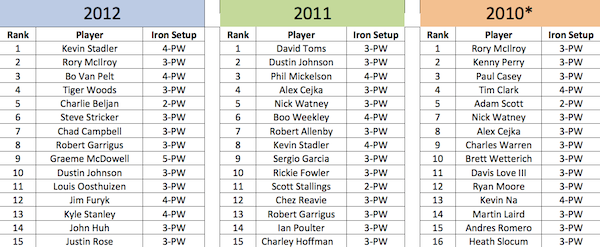
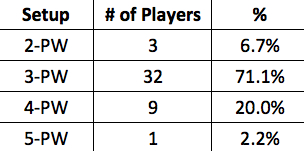






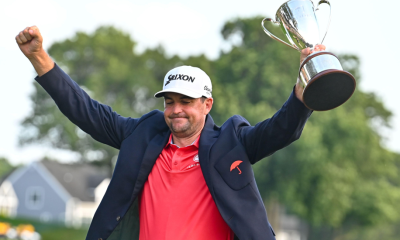



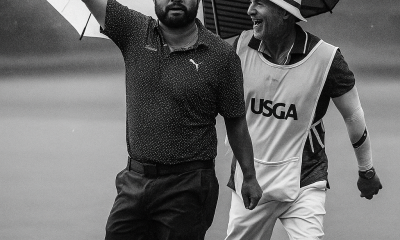

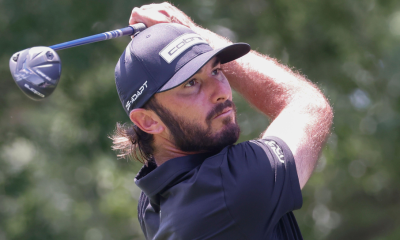









Scott
Jul 4, 2013 at 10:19 am
So this would require me to put some forethought into my round?
sam
Jul 1, 2013 at 12:16 am
Interesting stuff, here’s my 2cents worth…
PGA Tour players are just like other golfers, they follow trends. In the 90?s everyone on Tour jumped on the 52, 56, 60 bandwagon with Tom Kite, when he took distance control to a new level. Then along came Tiger with 48, 54, 58 and they all dumped a wedge. Lately, club lofts have changed the make up of sets, making 3 iron redundant in many cases (as shown above). The reason the DZ looks more important to scoring than the BZ is that relative to the other parts of their game the average PGA Tour Pro is poor in the BZ. The reason for this is simple: not enough tools to do the job. Modern PW clubs have become much stronger, instead of keeping the loft/distance gaps even, everyone followed Tiger and minimized the short end of their set. No doubt, more options and more full shot yardages will result in closer to the hole with wedges, it would be interesting to look at the correlation between number of scoring clubs and proximity to the hole, pretty sure you will find that guys with 3-4 wedges get it closer more often than the two club guys. Now that’s a blind spot!
Sppon
Jun 22, 2013 at 9:35 pm
so the conclusion is that the faster you swing, the more long irons you can use? Seems pretty obvious. I bet the bottom 50 in the danger zone stats have the same bag make up as the top 50 once you correct for club head speed. And I would also be shocked if having a higher clubhead speed doesn’t have a pretty good correlation with better performance from 200 yards. Luke Donald hits a 4 iron 205 yards. Dustin Johnson is hitting his 6 iron 202 yards.
The other thing to look at is the very poor repeatability in those lists. There is only 1 or 2 names that show up more than once. Is that a sign that this is pretty much a variance stat that has little to do with player ability?
Johnny
Jun 21, 2013 at 12:30 am
If belly putters are going to be banned, so should hybrids…..ill never touch one of those things…love my 3 iron
Tom
Jun 20, 2013 at 5:46 am
Hybrids are good for getting out of the rough sometimes and certain fairway shots, and especially if you don’t like or hit long irons good. But when you need to get out of trouble or carve in or draw that shot around something, or keep it extra low in the wind. I keep the 3-pw, with a 5wd too, but am now trying those Titleist utility irons, in 2,3, & 4. Hit them and felt they give the best of both worlds. 5wd may just go
Ron Hampel
Jun 19, 2013 at 2:19 pm
Don’t forget that many golfers (including pros, I think) value the ease of using a long iron (or current long iron replacements – AKA driving irons) for their superior ability to cut through tall turf vs hybrids. The smaller head simply makes the club glide through more easily.
Socorr4
Jun 19, 2013 at 2:01 pm
Thanks for this extremely interesting article. It’s very useful to a guy like me who comes from a scientific background and likes indepth analyses. BTW, I carry 3-pw, an 18 hybrid, a 54 or 56 (different bounce for different sand) and 64 wedges, driver, 3 or 4 fairway and putter.
Mat
Jun 19, 2013 at 2:28 am
It’s also worth stating that while these tour cats can whip a 3i, there are a few things you might want to mention:
* Playing from the tips might make you have more 3i shots. Play the whites, and you’ll rarely pull a 3 under any circumstance.
* Certain brands of irons are setting 4i lofts to 20 degrees-ier. Most pros consider a 3i to be 21*.
* Hybrids are an advancement tool, but at some point it needs to be accurate. If you’re hitting a hybrid only 175, you are probably going to have to go for the green.
* PRO players also like the longer irons because they land more softly. Your accuracy is often dictated in relation to the downward angle of the ball’s flight.
* Finally, many long irons pros are playing aren’t butter knives. There is a large level of forgiveness built into some of the 3 irons in play today. Angel Cabrerra comes to mind – blades, except for his i20 3i. The bag is going to Driver > Fairway > Hybrid > Drive Iron > 4-P & 2 wedges, or a lower hybrid and 3 wedges. Either way, the 3 iron is morphing just like the 5 wood did.
jb
Jun 18, 2013 at 7:31 pm
I couldn’t agree more, if you take the time to hit them all and then take the best feeling and have it fit to you, you’ll love hybrids. I hit Cobra ones and am in love with them. Able to hit from tough lies and still control and shape shots if need be. Couldn’t ask for an easier club to hit long and consistent.
Wayne Hall
Jun 18, 2013 at 6:08 pm
It is all about the shaft! Find the right shaft and the correct torque to match you golf swing and you will have a winner. I have tried most and even had some custom heads. The best performers have been Fubuki or Aerotech shafts in the Adams heads Super S (XTD) and a KZG Tour series. Make sure the shafts are heavy enough to help with flight and balance. Most shafts from the big brands are too light for the faster swing speeds.
Brian
Jun 18, 2013 at 12:23 am
Tour Players setup their bag almost exclusively for Par-5s and Par-3s. Those 6-8 holes on a course are what determines which clubs they play that week.
Cris
Jun 17, 2013 at 7:43 pm
This is a fantastic article. Always look forward to what you have to say, Richie. Thanks for sharing with us.
KCCO
Jun 17, 2013 at 4:49 pm
Is the 2 iron possibly a 712u? I could def see players carrying that……
Richie Hunt
Jun 17, 2013 at 4:52 pm
I didn’t count any Utility Iron or Driving Irons as part of the ‘irons.’ I don’t believe any of the players listed with the 2-PW where using a utility iron or driving iron as their 2-iron. They were using an actual 2-iron.
Nick
Jun 17, 2013 at 9:28 pm
I could be wrong, but I do believe Titleist confirmed Adam Scott is using the 712u 2-iron
Bailey
Jun 17, 2013 at 11:20 pm
You are correct, he is currently playing a 712u 2-iron. But in the study above when he was shown as a “2-iron” player, he was actually playing a real 2 iron. No driving iron, the real blade
Gregory
Jun 17, 2013 at 4:06 pm
The more GI a hybrid, the more likely it’s a hook machine. The “players” type hybrids with no to little offset are much different. Even players hybrids are so much easier to hit than gi long irons. Check out some of the Adams ones for better players used and cheap…like the idea pro, pro black, a12 pro.
Knallerich
Jun 18, 2013 at 2:56 am
in the last couple of years i used taylor made and ping hybrids (R11/i20)
Hooked them very badly so i tried adams and havent hit a hook ever since i bought a super xtd with the stock fubuki x-stiff shaft. if i try to hook it its a slight draw and i can even hit a fade with a hybrid now, so yeah, adams seems to be the solution for most better golfers.
bob poll
Jun 17, 2013 at 2:01 pm
who were the 3 with 2 irons?
Richie Hunt
Jun 17, 2013 at 3:02 pm
It’s in the table in the article. They were Charlie Beljan (2012), Adam Scott (2010) and Scott Stallings (2011).
Dalton
Jun 17, 2013 at 1:26 pm
Great article. Makes me want to be a sports statistician.
larry fox
Jun 17, 2013 at 1:46 pm
Great article!!
Eric
Jun 17, 2013 at 12:10 pm
I’ve always found Hybrids to be hooking machines. It could be that I haven’t yet found one that fits me. Instead I carry 4-PW irons and have replace my 3i with a persimon 5-wood.
Lawrence
Jun 17, 2013 at 1:15 pm
I agree – had a Taylormade 2011 3 rescue and called it a “prostitute” until lending it to a serial fader.
G
Jun 17, 2013 at 1:24 pm
I find that people who say that hybrids are hooking machines are also stuck with certain brands they prefer so they don’t search around enough and look at other companies to find the right club, being the fan-boy they are with their preferred brands.
Eric
Jun 17, 2013 at 2:31 pm
If you saw my bag you’d quickly realize that I’m not stuck with a certain brand or vintage. That said, it’s very possible that I just haven’t yet found the right one for me. It would be nice to get that high launch and soft landing 200-210 yards out.
G
Jun 18, 2013 at 2:56 am
You could work on your swing, can’t you? lmao
Michael
Jun 22, 2013 at 10:48 am
And you could work on your personality G. Eric, I’ve had the same issues with hybrids. Love hate relationship. I found a happy medium going to RBZ tour long irons. with their wide soles they give the benefit of hybrids with easy launch and movement through the rough, however you get the accuracy of an iron.
MP
Aug 16, 2013 at 4:27 pm
One suggestion could be to get fitted for the correct shafts or spend some money on lessons to cure the hook. so many people buy the latest driver every year and still cant hit it correctly. get some lessons and get fitted.
david
Dec 13, 2013 at 4:24 am
That’s a great point… unless you are getting paid on Sunday evenings for your 4 day performance it would behoove the average player to experiment with different brands of clubs and also with different offset/ shaft flex combos as well to see what ball flight, movability and distance each club produces for them.
I recently changed shafts in my 3 tour hybrid from an 80 gram S flex to a 65 gram R flex and shortened it’s length. This change gave me the yardage I was looking and the flight that I needed… hope this helps someone who is struggling.
NeillR
Jun 17, 2013 at 8:45 pm
I’m more than happy with my hybrids – currently have an RBZ (1st gen 3H) and a Titleist 910 (4H). Don’t have any problems with hooking and find that they are so versatile that i’m even looking at getting more of them!
Zack
Jun 17, 2013 at 9:39 pm
Yup I have the same problem. Why not try a driving iron?
pablo
Jun 20, 2013 at 2:15 am
I used to hook my 3h and 4h clubs badly until I decided to start fading them instead of drawing them. That solved everything and now they fly higher and land softer.
paul
Jan 8, 2014 at 6:30 pm
+1 to that comment. go for a fade with hybrids if they are gi. I play i20 and as long as i dont aim to play a draw, they are amazing.
Scott
Feb 18, 2015 at 12:07 pm
FYI. The older Adams PNT Tour version hybrids are not hooking machines. They have the yellow strip on the bottom and only show the loft. Awesome hybrids. You can work the ball and hit them from any condition. I have 3 (18 degree, 22 degree and 24 degree) and interchange based on course conditions. You can pick them up on ebay.